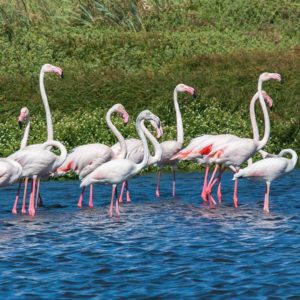A new baby flamingo is born. But how flamingo adults mate? Here is what science has to say about how flamingos make babies.
When flamingos are about six years old, they are ready to start mating. They will pair off and then engage in a variety of courtship rituals to find their mate. Females make a selection. So, if a male has impressed a female, she will decide to pair up with him. If not, then a fellow flamingo has to continue looking for another lady flamingo. But, there is more.
Flamingo Breeding Season
Flamingos are highly social animals, and they live in flocks or colonies that can number in the tens of thousands. So when mating is about to take place, the entire colony is going to take part in it. Meaning, all the colony’s chicks are born at the same time. Also, a fascinating fact is that flamingos help each other care for offspring.
Flamingos will usually mate when it rains. Why? Well, the rain helps flamingos to have necessary items for building nests. It also means there will be more food supply.
Flamingo Mating Dance
To attract a partner, male and female flamingos both participate in group dances. The mating ritual involves marching, preening, head turning and it begins with the ‘head-flag.’ Meaning males extend their heads and wave them back and forth. Then they spread their wings to display their black feathers. This move is called the ‘wing-salute.’ They also angle their heads downwards and their tails upward, so their black feathers point up to the sky.
But, the dancing rituals are not enough. Nope, males also apply makeup around breeding time to attract mates (https://link.springer.com/article/10.1007/s00265-010-1068-z).
Flamingo’s tails contain glands that produce oil that they spread onto their wings with their beaks. This preen oil is rich in carotenoids, and the flamings apply the oil during the mating season. Once they stop applying their make-up, which is soon after their chicks hatch, they will also lose the bright colors of their wings.
Other dance moves are ‘twist-preen’ (when male twist their head beneath a wing), the ‘wing-leg stretch’ (outstretching leg and wing on one side of the body), marching (this is a synchronized step performed by males, it is quick and performed while clustered together and standing erect).
After some preening, males proudly run together with their beaks pointed upward and their long beautiful necks stretched upwards. Next, females initiate copulation. All these happen in the water. When a female selects a male, she will then stop walking, it will lower her head, spread her wings, and invite her chosen one to mount her from behind and pass sperm from his cloaca to hers. A male jump on her back to mate.
(cloaca is waste and reproductive orifice)
Nesting Time
Flamingos are generally monogamous, and they stay faithful to their partners until the baby is born, at least. The male and female bird will mate periodically, and during that time, both flamingo parents get busy creating nests on the ground. The preparation starts during, or as soon as mating is over, which is about six weeks before an egg is laid. Females usually lay only one egg.
To build a nest, parents collect a different kind of items and push this material with their feet into a selected spot. When ready, these nests look like small volcanos, and they are about 12 inches high. They are made from anything from stones, muds, sticks, and feathers. After the nest is done, the female will lay an egg.
It will take from 27 to 31 days for the offspring to be born. The parents take turns incubating and protecting the egg, occasionally lifting and turning the egg with their beaks.
What is flamingo egg size? The egg is roughly 9 centimeters long and 5 centimeters in diameter.
Common Baby Flamingo Hatching
It takes between 24 to 36 hours for flamingo chicks to hatch. Their legs are pink, thick and swollen. The swelling goes down within 48 hours. For five to twelve weeks chicks live in the nest, although some may walk short distances during that time.
After 12 days they join the rest of the flock or so-called nurseries. Interestingly enough, as much as little nestlings might look to our eye all the same, parents flamingos recognize their baby. Parents can easily recognize their nestling’s call, even after they have joined the nursery and parents feed only their babies.
Before even leaving the nest, and quite early, within four to six weeks, since they hatched, chicken learns to swim and filter-feed.
How Do Baby Flamingos Turn Pink?
When chicks are born, both parents take a constant care of their baby and parents do not leave the nest for about a week. Here parents feed their baby with a red crop ‘milk.’ Both parents can product the ‘milk’ from their upper digestive system. This milk is rich in fats and protein. It also contains traces of the parents blood.
When the baby is strong enough, the parents and the baby will join the colony and a group of adults will care for the little one.
Next, the adults within the group will tich new babies how to swim and how to hunt food.
When born, baby flamingos often look like small cute fluffy cotton balls, either white or gray. Correct, babies get pink much later, perhaps when they are about three years old. They turn pink due to their diet. They get their pink color from special coloring chemicals called pigments found in the algae and invertebrates that they eat.
FAQ
Are flamingo eggs pink?
No, they are white oval shaped eggs.
What are baby flamingos called?
Baby flamingos are called Flaminglet.
How many babies do flamingos have at a time?
One.
